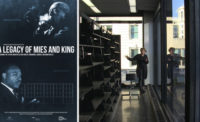The best architecture photographers use light and perspective to elevate what could be static images into single-frame movies, documenting places as organisms full of verve, mystery, and life. Ezra Stoller might be the first name in the architectural photography conversation, but PBS’ American Masters series makes a strong case that it should be Pedro E. Guerrero.
The inspiring, albeit limited, 60-minute documentary profile Pedro E. Guerrero: A Photographer’s Journey, which aired Friday, September 18 and can be viewed online at PBS.org, introduces us to a photographer who deserves far greater recognition. (Google “Pedro Guerrero” and most of the first two pages of results are about a former baseball player with that name.) Guerrero, who began his career as a 22-year-old amateur with no architectural knowledge, ultimately made his name chronicling Frank Lloyd Wright’s projects and, later, mid-century interiors and the work of artists Alexander Calder and Louise Nevelson. But it’s his work with Wright that would define him—and, to an extent, Wright.
In the late 1930s, after returning from art school in Los Angeles to his home in Mesa, Arizona, Guerrero needed work and direction. His father suggested he contact Wright, whose winter compound was in nearby Scottsdale, for a job. Guerrero did. Wright, in need of a photographer, hired him, and the beginning of a life-changing relationship was born.
Guerrero photographed Taliesin West, residential projects, and, later, the Guggenheim. He had a keen eye for capturing the architect’s work. He would circle it, observe it, and “find things falling into place the way I wanted them to,” Guerrero says in the film. One critic adds that Guerrero “spoke the language of Frank Lloyd Wright,” and it’s hard to argue when you look at his images from Arizona. His 1940 photograph of the Taliesin West’s drafting studio, for instance, is dramatic and heroic: The long, geometric structure grows out of the desert at sharp angles, surrounded by cactus with the reflecting pool seemingly connected to the marbled sky above. Wright’s construction is locked in an eternal ballet with the natural world.
The experience with Wright shaped Guerrero and his career. Wright gave Guerrero his first break, exposed him to a world that would otherwise have been closed to a Mexican-American person of limited means, and gave him entrée to the elite arts and culture scene of New York. The relationship proved to be Guerrero’s ticket into the magazine world (he shot homes and interiors for Home & Garden for 20 years), which brought him into contact with Calder and Neveslon. “When Wright was alive, he was really, totally the center of my universe, you might say, and one of the greatest influences on my life, outside of my own father,” Guerrero says in the film.
But the relationship was mutually beneficial. Guerrero’s photos of Wright’s buildings—and his portraits of the architect—shaped how the world saw both the man and his accomplishments. Though Wright adopted an aristocratic affect, through Guerrero’s keen lens he comes off a stately workman, a Victorian gentleman, and contemplative elder statesman. These images are indelibly linked with our perception of Wright, thanks to Guerrero’s sensitive eye. Whether it’s interior or exterior architectural photos, shots of the Fellowship working on Taliesin West, Calder manipulating materials into mobiles, or Nevelson directing assistants in her studio, humanity radiates out of Guerrero’s images.
For many, Pedro E. Guerrero: A Photographer’s Journey will likely be the first introduction to Guerrero’s life and work. It’s an excellent primer, built on a single “exclusive, in-depth” interview with Guerrero recorded shortly before his death in 2012. But with only a one-hour runtime, the documentary leaves much unsaid. Nearly 30 minutes is spent on his collaboration with Wright, while the rest is left to cover the next 50 years, including his work with Calder and Nevelson. What’s noticeably absent is his time as an official member of Wright’s Fellowship (which lasted a year) and his experience as a Mexican-American in a racially divided culture (at black-tie parties in New York and Connecticut he was routinely mistaken for a waiter), among other defining aspects of his life.
Guerrero explores those topics in his autobiography, also titled Pedro E. Guerrero: A Photographer’s Journey, which makes you wonder about the content of that core interview. What wasn’t used? Could it have been shaped into a film on its own? With those questions in mind, it’s easy to imagine a different kind of film. Historical and critical context from scholars and experts is certainly important, but in this case allowing Guerrero narrate his story, generously illustrated with his iconic images, would have been a far richer introduction to an artist worthy of wider acclaim.














Post a comment to this article
Report Abusive Comment